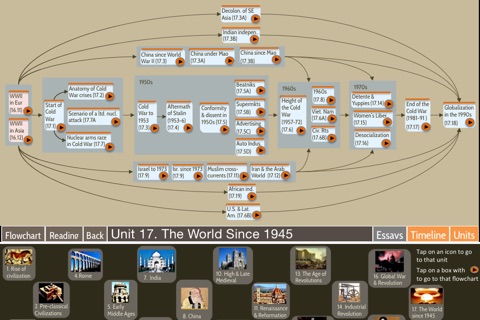
Pinch zooming for all versions
50% schools discount
The Flow of History is history for the 21st century.
Its history as it should be experienced: a dynamic fluid process instead of the standard names & dates approach to history you learned to hate in school, The Flow of History gives you world history in a series of 243 hyper-linked full-color flowcharts. Now you can explore the connections between various historical events & processes, both across time & between cultures.
The core idea is to show the dynamics of history, how different forces & events (political, social, economic, & cultural) have interacted over time to create our world today.
Each flowchart is a self-contained 1-page overview of a particular topic & a hyper-linked doorway to the people, events, & forces that affected different eras of history & were affected in turn by them.
Embedded in the links between flowcharts is the idea that the impact of any event in history neither begins with nor not stops at the end of that flowchart. Thus The Flow of History functions in essence as one flowchart broken into 242 sub-flowcharts hyper-linked to encompass the entire human story.
The Flow of History can be a quick reference tool and study guide for specific historical topics, the starting point for deeper research with its hundreds of picture essays, or an integrated world history tied together by hundreds of internal hyper-links.
Heres what you get:
• 243 hyper-linked flowcharts including
• A master flowchart linking you to all 17 units
• 17 unit flowcharts linking to each flowchart in that unit
• 225 full color flowcharts covering both standard topics (e.g., politics, religion, art, women, etc) as well as less standard topics such as festive dancing, disease in history, and even the humble potato)
• Detailed readings for each flowchart
• 17 full-color illustrated timelines
• Hundreds of picture essays on topics related to the flowcharts.
If the flowcharts are analytical and give the big picture of history, the picture essays are anecdotal & give depth to each topic, focusing on individual personalities & details on such logistical topics as how to make a fresco or how a matchlock musket worked, along with the stories that make history fun, funny, inspirational & interesting. The Hitler chapter alone has 19 picture essays on such topics as his propaganda, political techniques, art, love life, fascist childrens literature & math problems, & the Hitler Youth.
Just for fun, parodies (with flowcharts, & picture essays) on Godzilla and Santa are included.
Whatever your historical interests or needs The Flow of History is the first place to go.
A teacher review:
"The response from my summer school students has been better than I
> expected. Many of these students scored around 20% in the pre class
> assessment. The summer midterm results show that every student is retaining
> the information well above passing level with an average of 91. Many
> students have relied on the flow chart as a visual, but I have found many
> students making their own flow charts to focus on areas where they are in
> most need.
> Not only does the flow chart create a visual, but it also shows how events
> are related in a wonderfully organized fashion."
For further testimonials, go to http://www.flowofhistory.com/testimonials
The author has been building & refining this approach to history over 35 years of teaching. Among his teaching awards, he received the Beveridge Family Teaching Award in 2001 (the only teaching award given by the American Historical Association to a secondary school history teacher and was a 2014 finalist for the Battey national teacher of the year award given by Depauw University. For an article go to www.news.illinois.edu/ii/01/0405/0405butler.html
For sample (non-hyperlinked) flowcharts, check out www.flowofhistory.com
Interface, architecture design, & logo by Andre C. Murnieks, Professor of Design at University of Notre Dame.



